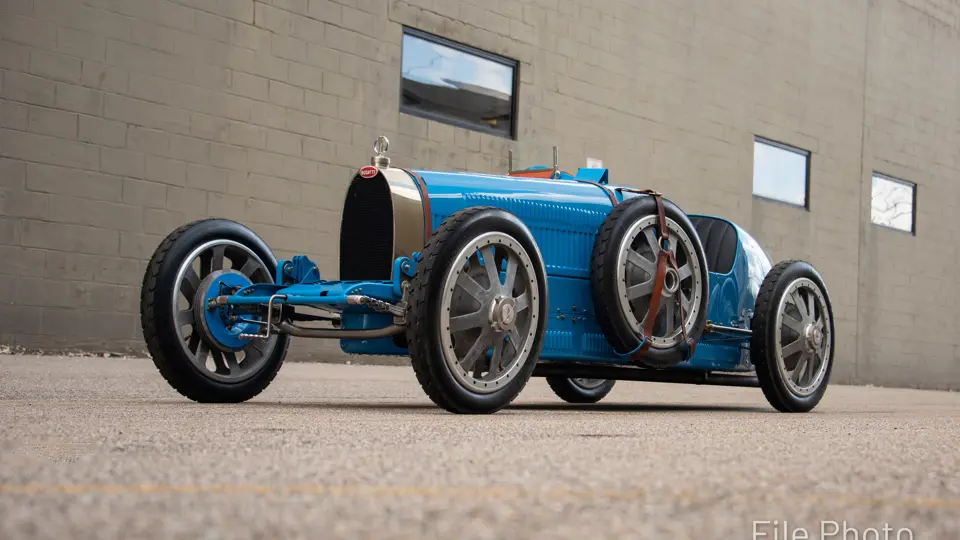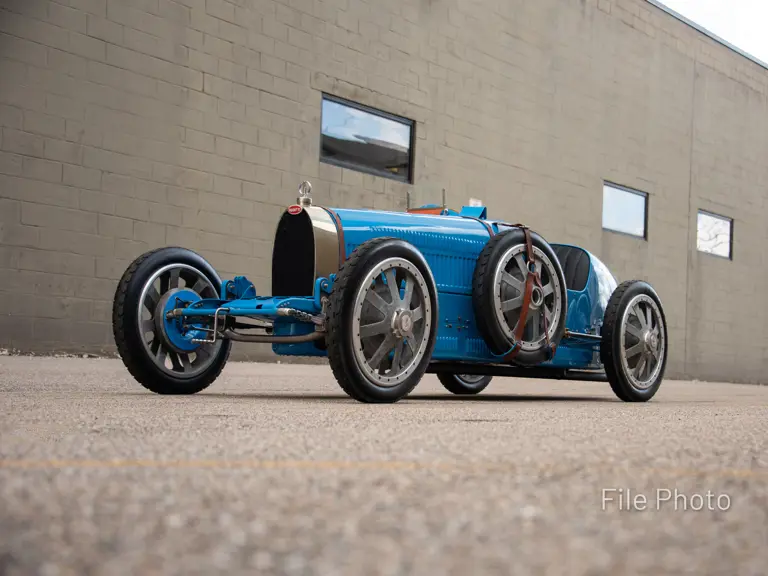
1927 Bugatti Type 37A Grand Prix
{{lr.item.text}}
€2,000,000 EUR | Asking
{{bidding.lot.reserveStatusFormatted}}
- One of just 78 Type 37A models produced at Molsheim between 1927 and 1931, and one of six delivered to the UK
- Brooklands racing history in the hands of R.C. Stewart, Peter Rogers, Ian Pollock, and Bill Craig
- Competed in the 1930 BRDC 500 mile race at Brooklands, driven by Messrs Pollock and Craig
- Acquired in 1946 by future World Land and Water Speed Record holder Donald Campbell
- Subsequently owned by noted Bugatti authorities Ian Preston, Roger Howard, and Terry Cardy
- In long-term ownership with Belgian Bugatti enthusiast Jos Wuyts from 1993 until 2019
- Highly original, retaining its original chassis, engine, gearbox, and rear axle
- Accompanied by a detailed 90-page report by marque experts David Sewell and Mark Morris
“To put it simply, this is an outstanding example of the Type 37A, supercharged 1.5-litre four-cylinder Grand Prix Bugatti.” -David Sewell & Mark Morris
THE TYPE 37A
Initially introduced in late 1925, in unsupercharged 1.5-litre form, the Bugatti Type 37 borrowed heavily from its predecessor the Type 35, not least in its exquisite proportions and superb engineering. Featuring a near-identical chassis and body, albeit with a three-valve, four-cylinder engine employed in place of the Type 35’s straight-eight unit, Bugatti’s new design was perfectly positioned for the incoming 1926 Grand Prix regulations which now stipulated a 1.5-litre capacity limit.
However, although the Type 37 drew widespread praise for its agility, handling, and reliability, its comparatively modest output of around 60 horsepower inevitably led to demands for a supercharged version. In response, the Type 37A variant was announced in mid-1927; the addition of a single Roots-type supercharger increasing power to around 90 horsepower, and permitting maximum revs to be increased from 4,500 to 5,000 rpm.
Arguably one of Molsheim’s most versatile designs, the Type 37 appeared in events as diverse as the Mille Miglia, Eifelrennen, Spa 24 Hours, and Le Mans 24 Hours; the last-named witnessing perhaps the model’s finest hour when Sébilleau and Delaroche finished a magnificent sixth overall in 1932. In total, it is believed that production extended to some 286 cars, of which just 78 were supercharged Type 37A variants.
CHASSIS NO. 37299
According to contemporary Molsheim records, chassis 37299 was constructed in August 1927 to the order of London Bugatti agent Colonel W.L. Sorel D.S.O; the car being equipped, as a genuine Type 37A, with a 1.5-litre supercharged engine to which the number 190CP was assigned. One of just six Type 37As delivered to the UK, it arrived at Col. Sorel’s premises on 17 October 1927, duly fitted with black wire wheels. As was customary at the time, a registration number was assigned on a local authority basis; the then London County Council allocating the licence plate XV 1673 sometime in late 1928.
Prominent Brooklands competitor Ronald Compton Stewart—later Sir Ronald, upon inheriting the family Baronetcy—acquired the car prior to the start of the 1929 racing season, and subsequently entered 12 Brooklands Automobile Racing Club races that year at the Surrey track. Records indicate that finishes were achieved in nine, including one win, one second, and two third places; the car distinctively competing with its driver’s side aero screen removed. Remarkably, it regularly lapped in excess of 110 mph–an impressive feat given its relatively modest power output.
The arrival of an Alfa Romeo 6C 1750 for 1930 prompted Stewart to sell the Bugatti; the latter being acquired by his fellow competitor Peter Rogers. In Rogers’ ownership, 37299 competed in a further nine races at Brooklands between March and June 1930, as well as contesting the Sand Races on Skegness Beach, in Lincolnshire, and the Lewes Speed Trials in East Sussex. Significantly, in Rogers’ final event at Brooklands—the BARC Whitsun meeting on 9 June—the car lapped at some 113.71 mph, securing second place in the Senior Long event in the process.
However, having owned the car for only a matter of months, the 22-year-old Rogers was tragically killed in a flying accident on 15 July 1930. At the behest of his family, 37299 was sold to Ian Pollock in September that same year; the latter promptly entering the car for the 1930 BRDC 500-mile race that October, with his cousin Bill Craig retained as co-driver. While their ultimate result remains a mystery, it is worthwhile referencing the superb quality of the race entry; the likes of “Sammy” Davis, Earl Howe, Sir Henry Birkin, Dudley Benjafield, and Giulio Ramponi all participating in one of the most prestigious races on the Brooklands calendar.
Pollock and Craig would continue to race the car at Brooklands on a further nine occasions in 1931; the latter raising his best lap speed to some 116 mph at that year’s Easter meeting. Furthermore—while not strictly speaking a competitive event—37299 and Craig also took part in a match race at the circuit on 18 April 1930, in which both were pitched against factory Norton motorcycle racer Bill Lacey. Regrettably, once again the outcome of the “race” is not recorded, but it was significant as contemporary photographs show the Bugatti running cast aluminium Grand Prix-type wheels, and larger 330mm brake drums, for the first time.
By 1934, ownership of 37299 had passed to London-based Bugatti specialist Leon Bachelier, whose personal collection around this time included two Type 43s and a delectable Jean Bugatti-bodied Type 55 Roadster. During his ownership, Bachelier appears to have re-registered the car BPE 660, and loaned it to his friend W.K. Faulkner to contest the Bugatti Owners’ Club Hillclimb at Chalfont St Peter on 26 May 1934. Although advertised for sale in The Motor the preceding week—for the princely sum of £200—it is understood that the car remained in Bachelier’s custody until his death in 1937, subsequently passing to legendary Bugatti dealer Jack Lemon-Burton.
Lemon-Burton sold the car briefly later that year to a Mr. Perrson of London, although by 31 July 1937 it had returned to his care. It remained at Lemon-Burton’s West London premises for just under a year, at which point it was sold to 19-year-old Cambridge University undergraduate Richard Habersham. In his ownership, 37299 competed in Bugatti Owners’ Club, Vintage Sports Car Club, and Cambridge University Automobile Club events, including three appearances at Donington Park.
It appears that the onset of war prompted Habersham to dismantle the car, as it was in this state that subsequent Grand Prix driver and Aston Martin team manager Reg Parnell—or possibly his mechanic Stan Burnett—acquired it in 1944. Chassis 37299 then passed through the hands of London-based enthusiasts Jack Lawrence and Robert Arbuthnot later that year, prior to its purchase by future World Land and Water Speed Record holder, Donald Campbell in or around 1946. As the son of arguably Brooklands’ most famous Bugatti exponent, Sir Malcolm, it would appear that the famous badge also held considerable—and justifiable—appeal to the younger Campbell.
While the car’s pre-war and immediate post-war history appears somewhat congested—if refreshingly well-documented—the years since offer a direct contrast, with just six further changes of ownership between 1950 and the present day. In 1950, 37299 (by now sporting a third registration number, HGT 874) was acquired by Cambridgeshire-based farmer Frank Sergeant, who set about completing its rebuild. Having restored and later used a Type 40 as his everyday transport from 1933 and 1944, Sergeant was well versed in the intricacies of Bugatti mechanicals, and 37299 was duly completed in time for the Bugatti Owners’ Club meeting at Silverstone on 16 June 1951.
Surprisingly however, Sergeant does not appear to have competed with the car again, despite retaining it until 1963. At this point, 37299 was sold to Ian Preston of Great Missenden, Buckinghamshire, who in turn sold the car in 1979 to Roger Howard of Stockport, Cheshire; the latter’s Type 43 forming part of a deal in exchange. Howard proceeded to compete with the car in selected Vintage Sports Car Club races and hillclimbs for several years, but was tempted to part with it by renowned Bugatti authority Terry Cardy of Bury St Edmunds, Suffolk, in 1985, in exchange for an incomplete Type 35C project.
As a serial “Bugattiste”, Cardy’s garage at the time included examples of the Type 23 Brescia, 35A, 35B, and 43A–in addition to 37299. However, following several years competing in VSCC events, he elected to sell the latter to Belgian enthusiast Jos Wuyts in 1993; this, incredibly, marking the first time that 37299 had ventured beyond British shores in almost seven decades. For the next 26 years the car would remain with Wuyts, during which time it participated in more than 20 International Bugatti rallies or other retrospective events.
Following the longest period of single ownership in its entire history, 37299 was acquired by the present owner in 2019. As is befitting of a car of such vintage and historical significance, it has been used sympathetically—if enthusiastically—ever since; a fact borne out by its consecutive participation in the Mille Miglia Retrospective every year since 2020.
If the sheer quantity of information and level of detail contained in 37299’s history file is truly remarkable, then its enviable originality—in terms of the retention of major components—and general state of preservation is no less impressive.
An accompanying report by marque experts David Sewell and Mark Morris remarks that the car retains its original chassis, engine, gearbox, rear axle and, likely, its aluminium coachwork. Furthermore, it is noted that the chassis retains its original number stamping of 500, and that this appears upside down and in the centre of the rear cross-member, exactly as per standard Bugatti practice. Other original items of note found on the car include—but are not restricted to—its Molsheim-stamped brass chassis plate, steering arms, track rod, draglink, drop arm, front leaf springs, front shock absorbers, cockpit bulkhead frame, and supercharger casing.
Reputedly Ettore Bugatti once remarked that his design philosophy was “pure blood, absolute clarity, predominance of purpose and immaculate shape”. Even if apocryphal, such a comment is entirely appropriate with reference to the Type 37; a design which remains–even with the passage of almost a century–as timelessly elegant as it is exquisitely executed.
In the case of 37299, there can be few cars of any vintage—much less any other Type 37 or Type 37A—with such a compelling and unambiguous continuous history, nor such remarkable originality. Indeed, that it has passed through the hands of some of the most respected names in the Bugatti fraternity—Bachelier, Lemon-Burton, Preston, Howard, and Cardy—says everything that is needed as to its appeal amongst the cognoscenti. Beautifully presented and retaining its priceless patina, it remains quite simply amongst the most significant of all Grand Prix Bugattis, and one guaranteed to steal the show in whichever arena it appears in the future.
This site is protected by reCAPTCHA and the Google Privacy Policy and Terms of Service apply.


 | Bologna, Italy
| Bologna, Italy


